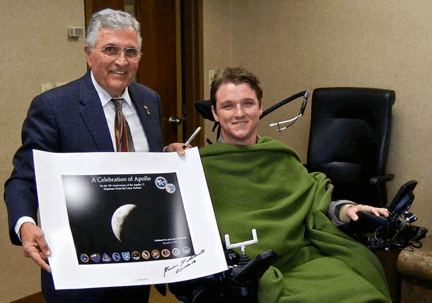Resources from Space
A FIELD TRIP TO THE MOON
Harrison H. Schmitt
Summary
The last Apollo mission to the moon, Apollo 17, left Earth on December 7, 1972 to land near the southeastern edge of Mare Serenitatis in the Valley of Taurus-Littrow. For 75 hours, Gene Cernan and the author lived and worked in the valley, performing extensive geological studies of the volcanic rocks that partially fill the valley, the boulders that rolled into the valley from the surrounding mountains, and the meteor impact generated soils that cover the valley floor and walls. Successful exploration of Taurus-Littrow capped a six mission investigation of the materials and history of the moon. At the conclusion of these studies, science had gained a first order understanding of the evolution of the moon as a planet. Humankind had gained knowledge of new resources in the soils of the moon that may help solve many energy problems on Earth and help initiate the exploration and settlement of Mars.
Introduction
Trips to the moon moved out of science fiction into reality on July 20th in 1969. On that date, Apollo 11 landed on the Sea of Tranquillity, extending the edge of human experience 400,000 km into space and to the surface of another planet. Five other landings followed. Apollo 17 became the end of this beginning of human movement into the universe.
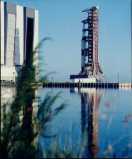 Apollo 17's trip to the moon
began with the roll-out of the huge,
imposing Saturn V rocket. With its slow emergence from the
Vehicle Assembly Building, the Saturn V and the two spacecraft at
its tip began the last Apollo trip to the moon.
Apollo 17's trip to the moon
began with the roll-out of the huge,
imposing Saturn V rocket. With its slow emergence from the
Vehicle Assembly Building, the Saturn V and the two spacecraft at
its tip began the last Apollo trip to the moon.
The largest rocket to carry humans into space, the Saturn V rose more that a football field in height (364 feet) and weighed 6.2 million pounds fully fueled [1]. Standing at the base of the stacked three stages, or looking across the top of the small solid fueled Launch Escape Rocket, Mission Commander Gene Cernan [2], Command Module Pilot Ron Evans [3], and I began to feel as well as see the immense size of this symbol of human ingenuity that would carry the three of us into space.
Training to go to the moon took many forms and included thousands of hours in spacecraft simulators, survival training in the jungles of Panama, and several days a month of science training (mostly geology) at various field locations around the country. Science training for the lunar surface crew aimed not at exposure to analogs of lunar features -- no good analogs exist on Earth -- but at using both instructive settings of comparable geological style and simulated lunar traverses to streamline and refine exploration procedures. We concentrated on sampling, documentation of sample setting, and communication of the essential details and interrelationships of materials and features we might encounter. In the process, we not only prepared to deal efficiently with unexpected discoveries, but polished the planning and operational skills of the entire mission team.
My presence on the crew of Apollo 17 resulted, of course, from the fact that my professional experience included geology, and a logical desire existed in many circles for a geologist to explore the moon before the end of the Apollo Program. Decision makers apparently also believed that my acquired skills in jet aircraft, helicopters, and spacecraft simulators had prepared me to perform well as a Lunar Module Pilot. I just thought going to the moon would be a great idea!
Earth to Moon
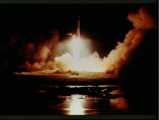
Eventually, with inexorable slowness, launch day came. But for us, rather than "day," launch night arrived. After a two hour and 40 minute delay, beginning a mere 30 seconds before the end of our first launch countdown at 10:00 pm, the block house crew bypassed a faulty launch computer instruction, and Apollo 17 began its trip to the moon.
Seven and one half million pounds of pulsing, crackling thrust from the five huge first stage engines, burning kerosene and liquid oxygen, first shook then lifted us toward space, turning night into day behind. In the midst of extraordinarily heavy vibration, forces of acceleration, or "G's" built up -- slowly, at first, then gradually increasing until, just before the S1C first stage burn ended at two minutes and 45 seconds, we had reached four times Earth's gravity. Then, the first stage shut down, the rocket stack unloaded in the absence of thrust, the now useless first stage dropped away toward the Atlantic Ocean, and the SII second stage ignited to continue our upward and southeastward journey. This sequence took us from plus four G's, to minus one and a half G's, to plus one and a half G's in just over a second. That gets your attention!
After about ten minutes, and smooth, liquid hydrogen and oxygen fueled rides on the second stage and the SIVB third stage, we reached a 90 nautical mile high circular orbit above the Earth. With the shut down of the SIVB, weightlessness enveloped us. This feeling of floating in water without any water gradually induced the first mild symptoms of space adaptation -- slight headache and slight nausea. These feelings became more pronounced with movement through the cabin and went away with a few minutes of inactivity. We found that over a few days, symptoms lessened and disappeared.
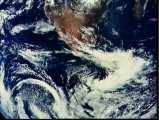 More intriguing, however,
were the expansive views of oceans, clouds, and continents below.
At 18,000 miles per hour and 90 minutes per orbit, patterns sped
by far too fast -- the South Atlantic and its washboard of
stratus clouds, the desert coast of southwest Africa, the burning
savannahs of Africa's interior, Madagascar, the towering thunderheads of the
Indian Ocean, cloud and shadow fingers of sunset, lightening
flashes in the South Pacific darkness, city glows through winter
clouds covering North America, and then the grid of lights of
Florida once again.
More intriguing, however,
were the expansive views of oceans, clouds, and continents below.
At 18,000 miles per hour and 90 minutes per orbit, patterns sped
by far too fast -- the South Atlantic and its washboard of
stratus clouds, the desert coast of southwest Africa, the burning
savannahs of Africa's interior, Madagascar, the towering thunderheads of the
Indian Ocean, cloud and shadow fingers of sunset, lightening
flashes in the South Pacific darkness, city glows through winter
clouds covering North America, and then the grid of lights of
Florida once again.
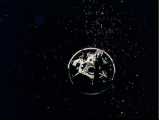 With all systems "go" in our
spacecraft and rocket, the third stage re-ignited to send us
toward the moon through the darkness over Australia, across the
banded colors of sunrise, and then directly away from Africa at
25,000 miles per hour. After retrieving
the Lunar Module Challenger from its launch cocoon in the
front end of the SIVB, we could relax and view the rapidly
receding Earth, the absolute highlight of the flight from Earth
orbit to lunar orbit.
With all systems "go" in our
spacecraft and rocket, the third stage re-ignited to send us
toward the moon through the darkness over Australia, across the
banded colors of sunrise, and then directly away from Africa at
25,000 miles per hour. After retrieving
the Lunar Module Challenger from its launch cocoon in the
front end of the SIVB, we could relax and view the rapidly
receding Earth, the absolute highlight of the flight from Earth
orbit to lunar orbit.
 At first, the blue and white
marbled Earth with its red, brown, and green continental rafts
filled only one window and, gradually, not even that. Our
photograph of a nearly full Earth with
Africa as its centerpiece, taken from 34,000 miles away, does
not do justice to the memories.
At first, the blue and white
marbled Earth with its red, brown, and green continental rafts
filled only one window and, gradually, not even that. Our
photograph of a nearly full Earth with
Africa as its centerpiece, taken from 34,000 miles away, does
not do justice to the memories.
Like childhood's home which we now only visit, changing in time but unchanged in the mind, we could see the full Earth revolve beneath us. The serpentine coasts of South America and Africa, like pieces from a child's wood block puzzle, bound the blue-black South Atlantic. The eastward bulge of the Amazon and the westward dent of the Congo appear to fit together so neatly that one can easily imagine their joint birth when an ancient super continent slowly began to split apart to form a new ocean.
Later, we can absorb all of South America with one glance from the historic Isthmus of Panama to the gale rent Straits of Magellan and from the streaming brown mouth of the Amazon to the jagged backbone of the Andes. At one point in the planet's rotation, only the brilliant white ranges, valleys, and plains of Antarctica remind the viewer that land still exists. The red-orange continent of Australia finally conquers this impression and becomes the Earth's natural desert beacon for the rest of our voyage.
As they slowly revolve into view, we watch the thunderhead capped islands of the Philippines, the South China Sea with its dense white typhoon Teresa, the gray-green island arcs of the East Indies and their turquoise lagoons, and the jungle blanketed regions of Southeast Asia. The Indian Ocean reappears to finally saturate the mind, and the cycle repeats.
The Moon
For three days, the fascinating changing scenes of an ever smaller planet Earth dominated our thoughts, until outside, a dark looming presence increasingly made itself felt as much as seen. The disk of the black, lightless moon grew in aspect, blocking more and more of the universal star field and then the mountains of the moon crossed the Earth itself.
Once in orbit about the moon, we looked first toward the airless sunrise and saw increasingly bright and glowing streamers radiating vast distances from a hidden sun. Then, just before sunrise, the center of each streamer became a spike of brilliant light piercing the dark lunar horizon like a luminous blade. A few high peaks cast their reflected light around the horizon's edge for a few moments and then, sunrise!
 At last, held to our own
cyclic wandering around the moon, we saw the Earthrise; that first and lasting symbol of a
generation's spirit, its daring, and its imagination.
At last, held to our own
cyclic wandering around the moon, we saw the Earthrise; that first and lasting symbol of a
generation's spirit, its daring, and its imagination.
When the time came to prepare for landing in the Valley of Taurus-Littrow, Gene and I activated the Challenger's systems and undocked from Ron, now alone in the spacecraft America. We would enter the valley from the east with the sun behind and below us for good shadow definition of rocks and craters. Like many other major lunar valleys, Taurus-Littrow extends radially from a large circular basin, in this case, the 500 km diameter basin called Mare Serenitatis. This huge basin formed about 3.9 billion years ago as a result of a large comet or asteroid impact. Subsequently, the basin and the valleys partially filled with dark volcanic lavas.
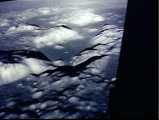 Anticipating exciting events
to come and after several orbits and some preliminary maneuvers,
we ignited the descent rocket engine for the twelve minute
braking burn that placed us on the valley
floor. Initially, we flew with our backs to the moon, looking
out into space. Beginning at about 5300 feet per second and ten
nautical miles altitude, the descent engine slowed our velocity
and bent our flight path toward an intersection with the lunar
surface. When the landing radar measured 6000 feet in altitude,
we pitched forward far enough that Gene could see the landing
area. We could both see the near-by, north and south sides of the
valley. I took one quick glance at the sights out the window and
went back to work, giving Gene the velocity and altitude
read-outs he needed to adjust the Challenger's flight toward a
touchdown away from large, potentially dangerous boulders and
craters but as close to the planned spot as possible.
Anticipating exciting events
to come and after several orbits and some preliminary maneuvers,
we ignited the descent rocket engine for the twelve minute
braking burn that placed us on the valley
floor. Initially, we flew with our backs to the moon, looking
out into space. Beginning at about 5300 feet per second and ten
nautical miles altitude, the descent engine slowed our velocity
and bent our flight path toward an intersection with the lunar
surface. When the landing radar measured 6000 feet in altitude,
we pitched forward far enough that Gene could see the landing
area. We could both see the near-by, north and south sides of the
valley. I took one quick glance at the sights out the window and
went back to work, giving Gene the velocity and altitude
read-outs he needed to adjust the Challenger's flight toward a
touchdown away from large, potentially dangerous boulders and
craters but as close to the planned spot as possible.
Dust began to stream away from the rocket as we went through about 100 feet above the surface. After Gene slowed a briefly too rapid descent, the six feet long probes beneath the landing pads touched, a blue light flashed on in the cabin, we shut off the rocket engine, and fell the last few feet to the surface. Slightly less than a second later, news of our landing arrived at Earth.
My first view out of the right-hand window, looking northwest across the valley at mountains 2000 meters high, encompassed only part of a truly breathtaking vista and geologist's paradise. Only later, when I could walk a few tens of meters away from the Challenger, did the full and still unexpected impact of the awe inspiring setting hit me: a brilliant sun, brighter than any desert sun, fully illuminated valley walls outlined against a blacker than black sky, with our beautiful, blue and white marbled Earth hanging over the southwestern mountains.
Indeed one of the most majestic panoramas within the view and experience of humankind confines the Valley of Taurus-Littrow. The roll of dark hills across the Valley floor blends with bright slopes that sweep evenly upwards, tracked like snow, to the rocky tops of the massifs two thousand meters above. The Valley does not have the jagged youthful exuberance of the Himalayas, or of the layered canyons of the Colorado, or of the glacially symmetrical fjords of the north countries, or even of the now so intriguing rifts of Mars. Rather, it has a subdued and ancient majesty. And we were there and part of it.
Gene and I spent about 75 hours on the moon, 22 of which comprised extravehicular activity (EVA) outside the Challenger. The Challenger provided one of the more serviceable and comfortable camps in my experience as a field geologist. The lower half, or descent stage, contained not only the big rocket engine that set us down in the valley, but also the equipment we would use during our exploration. In addition, the descent stage held the food, water, and oxygen needed for the three day stay. The upper half of the Challenger, or ascent stage, not only would take us back into orbit but provided a bedroom, kitchen, dining room, and bathroom.
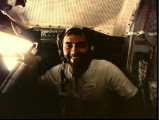 Although two large, empty
spacesuits made things cramped,
sleeping in one-sixth G provided better rest than on Earth --
just enough gravity to feel the hammock beneath you but not
enough pressure to cause you to toss and turn. The freeze dried,
dehydrated, and irradiated foods tasted fine, certainly better
than some food prepared by geological field assistants in Alaskan
field camps I have known. Possibly most important, there were no
black flies or mosquitoes.
Although two large, empty
spacesuits made things cramped,
sleeping in one-sixth G provided better rest than on Earth --
just enough gravity to feel the hammock beneath you but not
enough pressure to cause you to toss and turn. The freeze dried,
dehydrated, and irradiated foods tasted fine, certainly better
than some food prepared by geological field assistants in Alaskan
field camps I have known. Possibly most important, there were no
black flies or mosquitoes.
The first EVA saw a science station deployed and activated, as well as our first geological studies of the 3.8 billion year old, titanium rich basalt beneath the valley floor. This science station included experiments to investigate gravity wave induced oscillations, active and passive seismic activity, the composition of the thin lunar atmosphere, micrometeorite impacts rates, heat flow from the lunar interior, and neutron and cosmic ray fluxes.
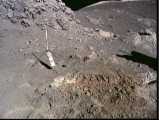 On the second EVA, the Lunar
Rover took us seven kilometers away from the Challenger to the
South Massif, where we sampled boulders at the base of the south
wall of the valley and explored an avalanche deposit that had
moved out away from the Massif. Our surprise, but not altogether
unexpected discovery of the orange
soil also occurred during the second EVA. This chemically
unusual material from 3.5 billion year old volcanic fire
fountains has given new insights into the origin of the moon and
the nature of its interior.
On the second EVA, the Lunar
Rover took us seven kilometers away from the Challenger to the
South Massif, where we sampled boulders at the base of the south
wall of the valley and explored an avalanche deposit that had
moved out away from the Massif. Our surprise, but not altogether
unexpected discovery of the orange
soil also occurred during the second EVA. This chemically
unusual material from 3.5 billion year old volcanic fire
fountains has given new insights into the origin of the moon and
the nature of its interior.
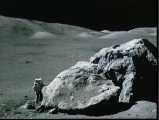 The third EVA provided an
opportunity to study the large
boulders that had rolled and bounced down the north wall of
the valley. From them, we hoped to learn more about what happens
when large objects from space hit, break, and partially melt
planetary crusts. During the detailed examination of one very
large boulder, the unexpected discovery of a subtle contact
between two types of impact generated debris units, one intrusive
into the other, again proved the worth of the trained human eye
in exploration.
The third EVA provided an
opportunity to study the large
boulders that had rolled and bounced down the north wall of
the valley. From them, we hoped to learn more about what happens
when large objects from space hit, break, and partially melt
planetary crusts. During the detailed examination of one very
large boulder, the unexpected discovery of a subtle contact
between two types of impact generated debris units, one intrusive
into the other, again proved the worth of the trained human eye
in exploration.
Questions often arise as to whether robotic exploration of the moon or any other planet would be less expensive than human exploration and provide all the essential scientific return. This question, of course, can never be answered to everyone's satisfaction if only because of sincere disagreements over what constitutes "essential science.". Clearly, robotic systems will and must make increasingly important contributions, however, the spontaneous human observation, integration, and interpretation of the total dynamic situation involved in space activities, and a calculated human response to that situation, will be as irreplaceable in the future as throughout the past.
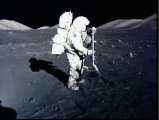 For us humans, one-sixth of
Earth's gravity made exploring the moon relatively easy even in
the confines of the bulky spacesuit.
Although my own weight plus the total weight of the suit and life
support system totaled about 370 earth pounds, the weight on the
moon was only about 61 pounds. If you wonder why the astronauts
seemed to be having so much fun working on the moon, it seemed
much easier than in the cumbersome spacesuits on Earth,
particularly as we had water cooled underwear to remove heat and
prevent sweating. With this cooling and a good cross-country
skiing stride above the surface, one can run easily across the
dusty but relatively firm regolith, possibly at a sustainable
rate of ten kilometers an hour. And it is fun, too.
For us humans, one-sixth of
Earth's gravity made exploring the moon relatively easy even in
the confines of the bulky spacesuit.
Although my own weight plus the total weight of the suit and life
support system totaled about 370 earth pounds, the weight on the
moon was only about 61 pounds. If you wonder why the astronauts
seemed to be having so much fun working on the moon, it seemed
much easier than in the cumbersome spacesuits on Earth,
particularly as we had water cooled underwear to remove heat and
prevent sweating. With this cooling and a good cross-country
skiing stride above the surface, one can run easily across the
dusty but relatively firm regolith, possibly at a sustainable
rate of ten kilometers an hour. And it is fun, too.
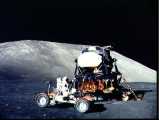 In our explorations of the
valley, we drove the Rover about 35
kilometers, collected and documented over 110 kg of moon rocks
and soils, and took over 2400 photographs. Gene used a rock
hammer (the grip fit him better than me) and a set of tongs for
most of his sampling, while I preferred a long handled scoop with
an adjustable head. We both had chest mounted, 60mm, electric
drive Hasselblad cameras, his loaded with color film and mine
with black and white for subsequent photometric measurements of
materials in place.
In our explorations of the
valley, we drove the Rover about 35
kilometers, collected and documented over 110 kg of moon rocks
and soils, and took over 2400 photographs. Gene used a rock
hammer (the grip fit him better than me) and a set of tongs for
most of his sampling, while I preferred a long handled scoop with
an adjustable head. We both had chest mounted, 60mm, electric
drive Hasselblad cameras, his loaded with color film and mine
with black and white for subsequent photometric measurements of
materials in place.
At most sampling sites, we generally worked together, using a specific sampling and documentation routine that provide significantly greater efficiency than working alone. While Gene dusted off the equipment on the Rover, I would look over the sampling area, giving a general description of the geology and what we would try to do. Then, I would take a down sun photo while Gene took a cross-sun stereo pair of photos of the area to be sampled. One of us would pick up rock or soil samples while the other held a numbered Teflon sample bag open to receive the sample. After stowing the bagged samples in larger bags mounted on our backpacks, one of us would take both a post-sampling photo to show which samples had been collected and a circular panorama that included the site. A running dialog of each step in the operation as well as other geological observations accompanied this process. The Rover color television camera, operated remotely from Earth, followed most of our activities, providing both additional scientific documentation and many humorous clips of our pratfalls to delight future audiences.
With our explorations over and a good rest behind us, the focus shifted to going back into orbit for a rendezvous with Ron. Preparations included review of seemingly endless contingency procedures to be used in case the normal, computer driven liftoff, ascent, and rendezvous sequences failed. So many engineering precautions had been designed into the Challenger, however, that little likelihood existed that we would be stranded on the moon. Indeed, I don't think any Apollo crew seriously contemplated what they would do in that eventuality. For example, among the hundreds of parts making up the ascent engine, only the exit nozzle and the massive fuel and oxidizer injector ring had no matching pair or backup component (No one could figure out a way these parts could fail.) As a last resort, we could even wire the descent batteries to the circuit breakers controlling the ascent engine fuel and oxidizer valves and force the valves open. As these pressurized liquids react on contact as they mix in the engine, we would be on our way.
We barely noticed the 1/2 G acceleration of liftoff and the slight oscillation during ascent, partly because at the instant of ignition, the uplink communications turned into raw static. Later, we found out that a mix-up on a transfer between Earth transmitting stations caused the problem. As we flew back into orbit on a direct rendezvous path towards Ron in the America, I spent the first few minutes trying to restore Challenger's communications while Gene monitored the guidance systems and yelled at me to "get the comm back!" (It turns out that nothing I could do would have helped. Mission Control finally restored communications on their own.)
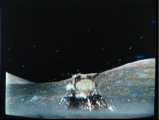 Rover television, commanded
to begin a vertical pan six seconds before engine ignition,
showed the world its first liftoff from
the moon. Unfortunately, the only film photograph of a lunar
liftoff came from a TV screen on Earth and suffers from extremely
poor resolution. Gene tried to persuade me to stay outside and
take a really good picture of liftoff, but I politely
declined.
Rover television, commanded
to begin a vertical pan six seconds before engine ignition,
showed the world its first liftoff from
the moon. Unfortunately, the only film photograph of a lunar
liftoff came from a TV screen on Earth and suffers from extremely
poor resolution. Gene tried to persuade me to stay outside and
take a really good picture of liftoff, but I politely
declined.
With the shutdown of Challenger's ascent rocket engine right on schedule, weightlessness once again invaded the cabin, this time in the company of a cloud of lunar dust from that accumulated beneath the floor grating. In a few minutes, the carbon dioxide removal system acted as an air filter and the cabin air cleared.
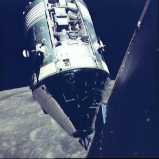 Following a routine rendezvous and docking with Ron, we
proceeded to transfer precious samples and film as well as the
EVA equipment Ron would use on the way home. Then came the
sadness of casting Challenger loose for its last trip to the
Valley of Taurus-Littrow and a crash for seismology near the
South Massif. Having lived for many years with Challenger (or
LM-12 as it is carried on the books) through design reviews, crew
function checks, vacuum tests, flight configuration checks, and
final tests, I had become attached to this inanimate object as if
it were a member of the family. Tough to let go.
Following a routine rendezvous and docking with Ron, we
proceeded to transfer precious samples and film as well as the
EVA equipment Ron would use on the way home. Then came the
sadness of casting Challenger loose for its last trip to the
Valley of Taurus-Littrow and a crash for seismology near the
South Massif. Having lived for many years with Challenger (or
LM-12 as it is carried on the books) through design reviews, crew
function checks, vacuum tests, flight configuration checks, and
final tests, I had become attached to this inanimate object as if
it were a member of the family. Tough to let go.
Moon to Earth
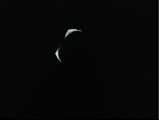 During three more days in
lunar orbit, remote sensing equipment scanned the surface, while
our visual observations focused on specific features beneath us,
including large areas of the now easily recognizable orange soil.
Finally, we prepared to leave the moon. A last Earthset preceded another perfect burn by
America's rocket engine, followed by a last Earthrise.
During three more days in
lunar orbit, remote sensing equipment scanned the surface, while
our visual observations focused on specific features beneath us,
including large areas of the now easily recognizable orange soil.
Finally, we prepared to leave the moon. A last Earthset preceded another perfect burn by
America's rocket engine, followed by a last Earthrise.
As the Earth rose, the horns of the sapphirine crescent contrasted with the edge of the bright lunar horizon as a jewel contrasts with a candle's flame. With the acquisition of radio signals, a friend of home spoke to us again, breaking the spell of the silent farside. We were on our way home.
Looking back at a full moon as we sped away, including a large portion of the farside, we could pick out all the sites of Apollo's explorations in addition to the features that corresponded with our new, remarkably detailed understanding of lunar evolution. The close-up view under direct solar illumination made it possible to outline the boundaries of color provinces of the lunar maria, each province probably corresponding to a distinct period of regional volcanic eruptions.
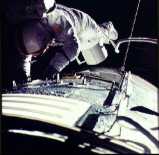 The planned trip back to
Earth would be about one-half day faster than going to the moon.
Besides preparing for entry into the atmosphere, our main task
involved recovering the film canisters from the remote sensing
experiments and cameras in one of America's external equipment
bays. Lunar surface oriented experiments included an radar
sounder, an infrared spectrometer, and a gamma ray spectrometer.
Recovery of the canisters required a tethered EVA by Ron, while I floated in the
open hatch and kept his umbilical untangled. Once Ron recovered a
canister, he would hand it to me and I would pass it inside to
Gene who would try to keep it from floating back into space. Ron
and I, at least, had a great time.
The planned trip back to
Earth would be about one-half day faster than going to the moon.
Besides preparing for entry into the atmosphere, our main task
involved recovering the film canisters from the remote sensing
experiments and cameras in one of America's external equipment
bays. Lunar surface oriented experiments included an radar
sounder, an infrared spectrometer, and a gamma ray spectrometer.
Recovery of the canisters required a tethered EVA by Ron, while I floated in the
open hatch and kept his umbilical untangled. Once Ron recovered a
canister, he would hand it to me and I would pass it inside to
Gene who would try to keep it from floating back into space. Ron
and I, at least, had a great time.
Ron quickly acquired the reputation of "chow hound" for the Apollo 17 crew. In fact, Gene and I worried about leaving him alone for three days with the food supplies. Although food remained when we returned from the lunar surface, all the good stuff, that is, everything with any flavor like bacon squares and chocolate, had disappeared.
All of us had to live with hydrogen gas in the water used to reconstitute various foods (basically the same as today's trail foods). Engineers never have been able to keep this hydrogen from diffusing into the water created when hydrogen and oxygen combine to produce electricity in fuel cells. Although the convenience of having a continuous supply of fresh water should be obvious, hydrogen going into our guts with the food had to come out, much to the discomfort of crew mates.
No lasting physiological effects resulted from nearly two weeks in reduced gravity. Neurological adaptation to the multisensory conflicts of micro-gravity took place within about three days, while other known aspects of the adaptation process remained asymptomatic. Gene and I experienced no one-sixth gravity readaptation symptoms after landing on the moon, nor did we lose our adaptation to micro-gravity up on return to lunar orbit. Radiation exposures were very low.
As entry into the atmosphere approached, our speed increased to about 35,000 miles per hour. We first separated from America's Service Module, relying on the Command Module's batteries to see us through to splashdown. Then, with the blunt end forward, we pointed the lift vector of the conical Command Module toward the Earth (at 35,000 mile per hour, even something that looks like a chocolate Kiss has lift like a wing). This insured capture by the atmosphere and avoided any danger of skipping out into space. As a consequence of this maneuver, we experienced a peak deceleration of seven G's. Seven G's takes a lot of grunts.
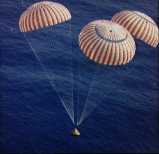 Once captured, the spacecraft
guidance computer held about four G's for several minutes. More
grunts required while the computer rolled its lift vector back
and forth, correcting our flight path toward where it believed
the recovery aircraft carrier waited in the South Pacific.
Actually, the computers demonstrated such accurate knowledge of
the planned point of splashdown that the Navy decided to cruise
several miles away in order to avoid any possibility of a hard
and embarrassing landing on the carrier's deck.
Once captured, the spacecraft
guidance computer held about four G's for several minutes. More
grunts required while the computer rolled its lift vector back
and forth, correcting our flight path toward where it believed
the recovery aircraft carrier waited in the South Pacific.
Actually, the computers demonstrated such accurate knowledge of
the planned point of splashdown that the Navy decided to cruise
several miles away in order to avoid any possibility of a hard
and embarrassing landing on the carrier's deck.
At 25,000 feet above the ocean the drogue parachutes (similar to those used for special fuels hot rods) deployed to slow us down even more. This short period actually surprised us by including the most violent motion of the flight. However, at 10,000 feet, the big, beautiful, red and white main chutes began to deploy. Although it seemed to take forever, all three chutes eventually filled, and we drifted to a amazingly low impact splashdown in the reportedly "gentle" swells of the blue Pacific near Samoa.
Reports of gentle swells did not take into account the strange shape of our spacecraft-turned-boat. Strange new motions, coupled with re-adjustments to Earth's gravity and the soak back of entry heat into the cabin, made me more uncomfortable than at any other time during the mission. No one became sick, but it was close.
 The efficiency of the Navy
frogmen saved us from the indignity of throwing up. Within a few
minutes, they deployed a flotation collar
around the spacecraft, inflated a staging liferaft for the
hoist to the hovering helicopter, opened the hatch, and handed us
each an engraved underwater knife. Soon, we reached for friendly
hands through the side door of the helicopter and flew to the
carrier Ticonderoga and the beginning of other adventures.
The efficiency of the Navy
frogmen saved us from the indignity of throwing up. Within a few
minutes, they deployed a flotation collar
around the spacecraft, inflated a staging liferaft for the
hoist to the hovering helicopter, opened the hatch, and handed us
each an engraved underwater knife. Soon, we reached for friendly
hands through the side door of the helicopter and flew to the
carrier Ticonderoga and the beginning of other adventures.
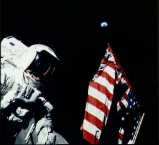 It may be possible to
anticipate much of the final legacy of Apollo even though the
long digestive tract of history has yet to
be traversed. For example, from materials and documentation
obtained at six Apollo landing sites, science has been provided a
first order understanding of the evolution of the moon as a small
planet and given new insights into the moon's origin and that of
the Earth. Indeed, we even gained new perspectives on the origin
of life on Earth and the possibility of early life on Mars.
It may be possible to
anticipate much of the final legacy of Apollo even though the
long digestive tract of history has yet to
be traversed. For example, from materials and documentation
obtained at six Apollo landing sites, science has been provided a
first order understanding of the evolution of the moon as a small
planet and given new insights into the moon's origin and that of
the Earth. Indeed, we even gained new perspectives on the origin
of life on Earth and the possibility of early life on Mars.
 History also may note the
discovery of concentrations of solar wind volatiles in the
pulverized lunar soils, and specifically a light isotope of
helium known as helium-3. Helium-3 has given applied science and
policy makers the option of new, environmentally acceptable
fusion energy resources as we search for an alternative to fossil
fuels.
History also may note the
discovery of concentrations of solar wind volatiles in the
pulverized lunar soils, and specifically a light isotope of
helium known as helium-3. Helium-3 has given applied science and
policy makers the option of new, environmentally acceptable
fusion energy resources as we search for an alternative to fossil
fuels.
Further, technology saw the development of a vast new foundation of know-how which can empower technical solutions for many of humankind's challenges, and human society viewed both the power of free peoples when faced with a challenge and the power of ideas when communicated instantaneously throughout the world. Most importantly, however, Apollo demonstrated that the curve of human evolution had been bent, that the species could survive in space and settle the moon, and that, indeed, the parents of the first Martians may be living with us today.
For Would-Be Astronauts
Selections of astronauts now occur more routinely and with much less fanfare than during the Apollo era. On the other hand, even more competition exists for the slots available because so many young people plan their education and careers with becoming an astronaut in mind.
At the start of the first scientist astronaut selection process in 1964, NASA received about 1400 applications, essentially none of which came from women. Just thirteen years later, at the start of the third scientist selection process, over 8000 applied, a third of whom were women. How quickly times change! The selection panel found that hundreds of these 8000 clearly qualified to be astronauts, and the toughest job became deciding which few would actually be selected in that round.
For those who aspire to become astronauts in this competitive environment, the number one priority remains education while number two is good health. Age and certain physical handicaps (vision abnormalities, disease history, etc.) become less and less critical with time and increased confidence in human performance in space. Specialties have become less relevant than education quality, breath of knowledge and experience, and depth of commitment. Almost all sub-disciplines of science, engineering, aeronautics, and health will find application in space flight crews. Eventually, with permanent space stations and settlements on the moon and Mars, most other professions, including teaching, journalism, business, construction, homemaking, and even law, should become a basis for selection.
Additional photographs and links
Footnotes
[1] The reader will soon note that we used a mixture of measurement systems in the Apollo Program. We built our rockets and spacecraft using the United States system, flew in space using the nautical system, and explored the moon using the metric system. If you get confused, you will know how the crews felt.
[2] Eugene A. Cernan, Captain (USN retired) now consults and lives in Houston, Texas.
[3] Ronald E. Evans, Captain (USN retired) died in 1990 after living and working in Scottsdale, Arizona for many years.

